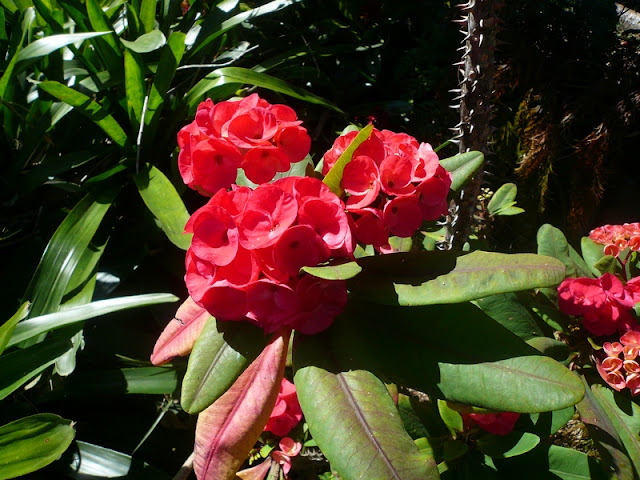Wake up early don't lose a day;
Callistemon, many to choose from; great gift for the birds;
Listen, and you can hear whispers in the trees...
Syzygium wilsonii subsp. wilsonii
This species is endemic to the far north Queensland rainforests, from Ingham to Cooktown, in lowland rainforests from sea level to 600-700m, growing in relatively poor soils. S. wilsonii subsp. wilsonii is suitable for a range uses and locations from Sydney to Cairns. This species can be easily incorporated into any patio, courtyard or rainforest garden.
It is a small shrub 1-3 m tall with extremely attractive flowers and foliage with clusters of edible fruit that attracts wildlife. It has weeping branches with lanceolate reddish brown new foliage. Stiff narrow leaves to 18 cm x 5 cm, dark green and dull on upper surface and paler on underneath side of leaf. This species is the only one of the lillypillies to have red flowers. They have large, fluffy heads and flower from spring to summer. White clusters of ovoid shaped fleshy fruits.
Syzygium - from Greek ‘syzygos’, joined, referring to paired leaves and branchlets of a Jamaican species.
A garden you can visit anytime;
Banksia integrifolia - Coast Banksia
Genus: Banksia
Species: integrifolia
Common name: Coast Banksia, Coastal Banksia - Tree, Trees
Botanical name: Banksia integrifolia
Origin: Australia, East Coast
Height: 15.0m - 18.0m
Spread: 8.0m - 10.0m
Flower: Pale yellow Banksia flower spike, cylindrical inflorescence, hundreds of flowers packed in a spiral, 10.0cm x 5.0cm, Late Summer, Winter
Leaf: Dull dark green upper, white underside, whorls of 3 - 5, entire, 10.0cm x 3.0
Emerging flower of Banksia Robur;
Banksia robur, commonly known as Swamp Banksia grows in sand or peaty sand in coastal areas from Cooktown in north Queensland to the Illawarra region on the New South Wales south coast. It is often found in areas which are seasonally inundated.
Although it was one of the original banksias collected by Joseph Banks around Botany Bay in 1770, it was not named until 1800 by Cavanilles, with a type collection by Luis Née in 1793.
Banksia robur is a spreading shrub to 2.5 m although can get a little larger in cultivation. It has very large, leathery tough green leaves with serrated margins up to 30 cm long and 10 cm wide. The new growth is colourful, with shades red, maroon or brown with a dense felt-like covering of brown hairs.
Plants from different areas seem to flower at different times, some spring-summer, others predominantly autumn. The stunning large flower spikes, up to 15cm high and 5-6cm wide, are metallic green with pinkish styles in bud, becoming cream-yellow and fading to golden-brown.In the golden stage. The old flowers turn grey and persist on old cones, concealing the small follicles. These follicles are reddish and furred when new, before fading. The plant is lignotuberous, regenerating from the ground after fire.
The stunning flowers of Grevillia Honey Gem;
Grevillia Honey Gem is very attractive to all birds, enjoying the nectar dripping flowers.
This is not easy to understand
For you that come from a distant land
Where all the colours are low in pitch -
Deep purples, emeralds deep and rich,
Where autumn's flaming and summer's green
Here is a beauty you have not seen.
From THE COLOURS OF LIGHT; Helen McKellar
The undemanding but beautiful, yellow flowers of Tristania neriifolia;
Tristania is a monotypic genus, native to New South Wales, Australia, closely related to Cistemon. The sole species in the genus is T. neriifolia.
It is a small tree, with dense branching. The leaves are evergreen, opposite, simple, lanceolate, from 5–9 cm long and 1 cm broad. The flowers are produced in dense clusters of 3-15 together; each flower is 1-1.5 cm diameter, with five small yellow petals and numerous conspicuous stamens.
It is commonly known as the water gum.
King Parrot;
The wonderfully fragrant Murraya;
Murraya paniculata, commonly called Orange Jessamine, is a tropical, evergreen plant bearing small, white, scented flowers, which is grown as an ornamental tree or hedge. Murraya is closely related to Citrus.
Traditionally, Murraya paniculata is used in traditional medicine as an analgesic.
Believe it or not:Think of the fierce energy
concentrated in an acorn!
You bury it in the ground, and it
explodes into an oak!
Bury a sheep, and nothing happens but decay. - George Bernard Shaw
Bury a sheep, and nothing happens but decay. - George Bernard Shaw
©Ts



















